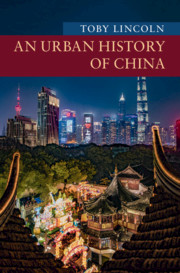Book contents
- An Urban History of China
- New Approaches to Asian History
- An Urban History of China
- Copyright page
- Contents
- Figures
- Maps
- Tables
- Acknowledgements
- Introduction
- 1 The Emergence of China’s Imperial Urban Civilization (Antiquity to 220 CE)
- 2 The Expansion of China’s Imperial Urban Civilization to the South (220–755)
- 3 The Tang-Song Transition and Its Effects on China’s Imperial Urban Civilization (907–1402)
- 4 The Flowering of Chinese Imperial Urban Civilization (1402–1799)
- 5 The Seeds of Urban Modernity (1800–1895)
- 6 Urban Modernity in Republican China (1895–1949)
- 7 The Maoist Period (1949–1976)
- 8 The Reform Era and the Present
- Conclusion
- Index
- Series page
- References
6 - Urban Modernity in Republican China (1895–1949)
Published online by Cambridge University Press: 29 April 2021
- An Urban History of China
- New Approaches to Asian History
- An Urban History of China
- Copyright page
- Contents
- Figures
- Maps
- Tables
- Acknowledgements
- Introduction
- 1 The Emergence of China’s Imperial Urban Civilization (Antiquity to 220 CE)
- 2 The Expansion of China’s Imperial Urban Civilization to the South (220–755)
- 3 The Tang-Song Transition and Its Effects on China’s Imperial Urban Civilization (907–1402)
- 4 The Flowering of Chinese Imperial Urban Civilization (1402–1799)
- 5 The Seeds of Urban Modernity (1800–1895)
- 6 Urban Modernity in Republican China (1895–1949)
- 7 The Maoist Period (1949–1976)
- 8 The Reform Era and the Present
- Conclusion
- Index
- Series page
- References
Summary
Industrialization was the catalyst for the spread of urban modernity across China in the first half of the twentieth century, although most factories were in large coastal cities and the northeast in Manchuria. The Japanese invasion of 1937 forced the Nationalist government and millions of people to move west, and cities such as Chongqing and Kunming grew substantially. Cities were now connected via rail, road, telegraph, telephone, and air travel, and the urban system was reconfigured along these new communications networks. Chinese cities acquired commercial and industrial districts, new administrative zones, parks, and residential areas, while new building technology and architectural styles transformed urban skylines. Experiments in municipal governance came together in a suite of new laws passed after the Nationalist government came to power in 1927 that sought to impose order and standardization across the country, and urban plans were produced for many cities, although many never made it off the drawing board. No longer was American, European, or Japanese culture confined to coastal treaty ports. Teachers, doctors, engineers, shop girls, bank clerks, and factory workers across the country were all able to purchase global brands, watch films made in Hollywood or Shanghai, and listen to jazz in clubs.
- Type
- Chapter
- Information
- An Urban History of China , pp. 162 - 190Publisher: Cambridge University PressPrint publication year: 2021

